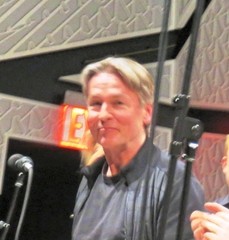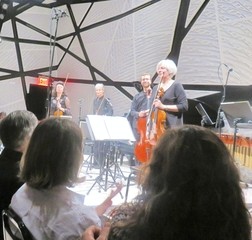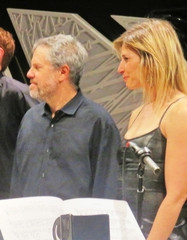|
Back
Sawdust in the Cosmos New York
National Sawdust, 80 North 6th Street, Williamsburg, Brooklyn
02/01/2016 -
Contact!: Salonen’s Floof And Other Delights
Witold Lutoslawski: String Quartet
Franco Donatoni: HOT For Solo Sopranino/Tenor Saxophone and Six-Member Ensemble
Niccolò Castiglioni: Dulce refrigerum
Esa-Pekka Salonen: Floof (Songs of a Homeostatic Homer)
Hila Plitmann (Soprano)
Musicians of the New York Philharmonic: Pascual Martínez Forteza, David Gould (Clarinets), Timothy Ruedman (Guest Saxophone), Thomas V. Smith (Trumpet), Colin Williams (Trombone), Anna Rabinova, Fiona Simon (Violins), Irene Breslaw (Viola), Nathan Vickery, Sumire Kudo (Cellos), Max Zeugner (Bass), Daniel Druckman (Percussion), Eric Huebner (Piano), Steven Beck (Guest Synthesizer), Joshua Gersen (Conductor)
Esa-Pekka Salonen (Curator and Host)

E.-P. Salonen (© Samuel A. Dog)
A century ago, amidst the squalid factories in Brooklyn’s Williamsburg section, a factory was opened to make...er, sawdust. In an area known for its miles of unhealthy mills and sweatshops, this sawdust factory had to have been the most insalubrious.
Today, keeping the original name, National Sawdust is a Brooklyn treasure of contemporary music. The black-and-white box, high-ceilinged, crisscrossed with girders and sound boxes, can initially make the first-time visitor (me, for instance) almost giddy, The angles, the jarring spaces, an area resembling a myopic trauma, on second thought could be an El Greco aberration.
Which means it is ideal for Contact!, the New York Phil’s contemporary music series, music which is not tonic-dominant, or lucid. Its offerings are (must be) quirky, difficult, eccentric and vision without borders.
And equally ideal for Esa-Pekka Salonen. No, he won’t be the New York Philharmonic’s next Music Director. That, though, is because Mr. Salonen, like his music, cannot be confined.
We know him as a conductor and composer. But he is an interlocutor supreme. In National Sawdust, he was in his element. No NY Phil “season subscribers”, no socialites. His audience was young creative, attentive, ardent, and above all, curious. Mr. Salonen, not worried about time, went on at length about each work. But his personality is not only joyous, his enthusiasms are infectious.
I would like to say that the opening work was the Lutoslawski String Quartet. More appropriate was Mr. Salonen’s memories–both learnéd and funny, anecdotal and explanational–of this, one of his most important teachers. In particular, though, he spoke of the composer’s only string quartet, as “sculpting in...almost liquid material.”

A. Rabinova, F. Simon, N. Vickery, I. Breslaw (© Samuel A. Dog)
That was achieved, simply, by the composer never writing out the entire score. Each instrument was given its own sheet, and the supposed unity could be taken at any pace whatsoever.
The result of the two movements varied. It started simply enough with a two-minute recitative by first violin Anna Rabinova. After that we begin an aleatory adventure. The players come near to unison with slashing octaves in C by all the instruments (though not quite in sync). At other times, we have whispers and pizzicati, a possible variation on the opening monologue.
It was serious stuff, though it could also have been part of Mozart’s “musical joke”. And at other times–oh, forgive me!–when the instruments play almost in tune, it sounds exactly like the horrible out-of-tune junior high school orchestra of The Simpsons, with all the wrong notes. It was riveting stuff.
The right notes followed, written by another of Mr. Salonen’s teachers, Franco Donatoni. This was straight jazz–what the late composer called “imaginary jazz”. Yet it could be played in any progressive jazz venue with no questions asked. Starting with a straight walking-bass line by Max Zeugner, Mr. Donatoni brought in the brass playing what seemed like all minor-second harmonies (perhaps too grating for real jazz), and then followed with sax and clarinet, all doing variations becoming more and more complex.
Possibly because I was sitting near the percussion section, I paid most attention to Daniel Druckman. And listening and watching him on vibraphone, tubular bells, wind chimes and a dozen other instruments, I have to say that he is either the Denis Matsuev of percussion, or (equally likely), Matsuev is the Druckman of the piano. Never have I seen so many sticks used in so many ways.
To reverse Abraham Lincoln’s famed line, Mr. Druckman offered “mallets towards all.”
The third work featured the Philharmonic’s pianist Eric Huebner. On March 9, Mr. Huebner is giving a recital in the Good Shepherd Presbyterian Church, with music by Dukas, Messiaen, Murail and others. For this moment, we heard six works by (to me) a new composer, Niccolò Castiglioni, who died in 1996 at the age of 64.
The six songs under a title meaning “sweet refreshment” were aphoristic, gentle (save for a playful Lied), fairly dissonant–and all of them played in on tinkling treble keys.
Mr. Salonen mentioned several times the influence of John Cage on Lutoslawski, and this could have been like Cage’s works for miniature piano. Save that Mr. Huebner essayed the dissonances and skips with his usual faultless confidence.

D. Druckman, H. Plitmann (© Samuel A. Dog)
Fine as the previous three works had been, their sobriety (even in HOT, their daring and expertise gave no indication of the final work, Esa-Pekka Salonen’s own mock-epically titled Floof (Songs of a Homeostatic Homer). Nor will space allow me to repeat the original description of the creation here, involving a science-fiction story, a “laboratory of musical ideas, the wilder the better”, and the idea of “Homer learning to be a poet: onomatopoeia becomes poetry.”
As well as a visibly trembling homeostatic Bard.
None of these poor words come anywhere the astounding music produced by soprano Hila Plitmann and an ensemble of clarinets, cello, huge percussion section (played again by virtuoso Druckman) and a “libretto” of both nonsense words (beginning with a Zen-shouted “Floof!”) and surrealistic poetry.
The only way to describe Ms. Plitmann is in three steps. 1. Imagine Mozart’s Magic Flute aria by the Queen of the Night; 2. Raise the gamuts up about five notes (Ms. Plitmann reached, I believe, a high F Sharp!), down an octave (to the tenor level). 3. Now mix up all those mix up those notes like letters in a Scrabble bag, throw them up in the air–and let the emotions roll.
Ms. Plitmann was a force of nature both physically with her body contortions, and musically, reaching the extremes, bursting through whatever glass ceilings normal voices go. She was coarse and savage, she trembled with the rare pure beauty parts (her voice duetting with the treble glissandi of cellist Sumire Kudo or the velvet-soft notes of Mr. Druckman). It was hilariously funny, percussive, stormy, amazing and mesmeric.
With the other works, one sometimes questioned “Why?” or “What does he mean?”. With Floof, one tossed rationality into the garbage can, for Mr. Salonen created the universe which Homer never imagined.
Oh, actually, Homer’s Jupiter–a.k.a. Jove–would have rocked himself with the most jovial laughter up on Mount Olympus, though perhaps fearing that Ms. Plitmann’s voice might set up an earthquake under his aerie. We were far too astounded to laugh out loud. The effect, though–and Mr. Salonen gleefully went on stage to thank his artists–was that of a Divine (and divinely produced) comedy.
Harry Rolnick
|